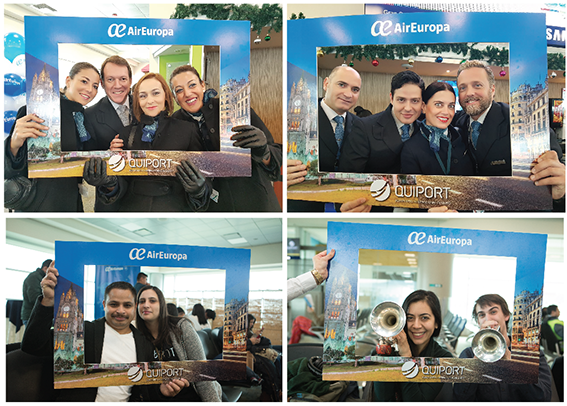Month: January 2018
APPROXIMATELY 15,000 TONS OF FLOWERS WILL BE TRANSPORTED FROM QUITO TO THE WORLD FOR VALENTINE’S DAY
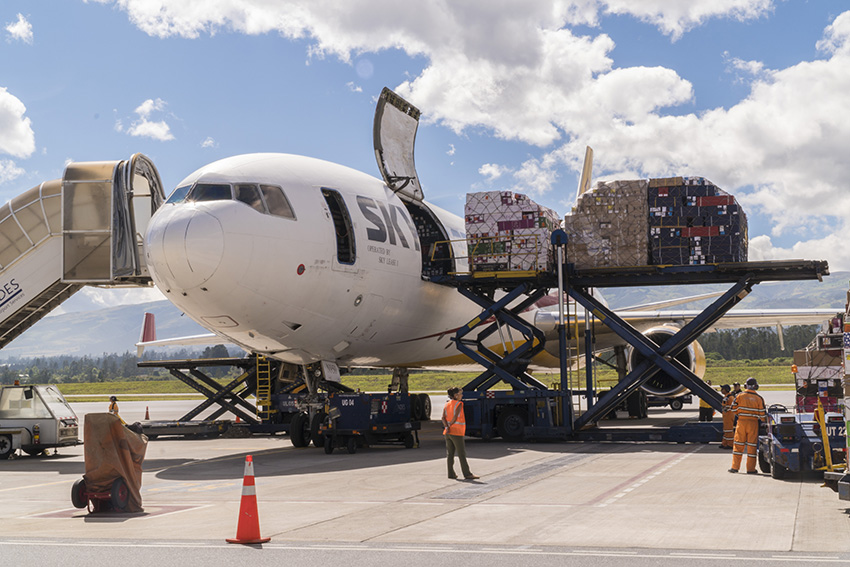
The peak cargo season at the Mariscal Sucre International Airport began on January 20 and will last until February 10. The air terminal has an expanded cargo platform to park large-size aircraft simultaneously, allowing a cargo of 15,000 tons of flowers – 15.4 % more than last year—to reach the world for the Valentine’s Day celebrations.
Varieties with great beauty and unparalleled quality make Ecuadorian roses one of the most sought-after products in the world, primarily during the Valentine’s Day holiday. Because of this, the Mariscal Sucre International Airport launched the 2018 peak cargo season with an expanded platform that permits the simultaneous parking of six large capacity aircraft (three code F aircraft (Boeing 747-800) and three code E aircraft (Boeing 747-400, Boeing 777-200 and MD-11)), which would facilitate the transport of approximately 15,000 tons of cargo— 15.4% more than last year, according to data provided by Corporación Quiport, concessionaire of the city’s airport.
According to Andrew O’Brian, president and director general of this entity, the Mariscal Sucre International Airport exceeded the sum of 13,000 tons transported during the peak cargo season last year. In 2018, a cargo of above 15,000 tons is projected, in 22 days. Expansion of the cargo platform was a measure taken by Corporación Quiport in order to satisfy the demands of one of the country’s principal industries, whose peak production period is for the Valentine’s Day season.
“We work towards contributing to the improvement of international trade conditions in Quito and Ecuador; our actions are focused on providing facilities to users, companies and airlines, to continue to make the Quito Airport a gateway for the country’s development,” stated O’Brian, who also highlighted the collaborative and swift work of the General Civil Aviation Directorate to make the platform operational in a timely manner. Quiport invested 3.5 million dollars in the expansion of the cargo platform.
The aircraft that can simultaneously load this national product as of January 20 in this ample space and in accordance with international standards, all have large sizes and capacity as common features. A code F aircraft carries 120 tons, while a code E aircraft transports between 90 and 110 tons. During the 22 days that the peak cargo season lasts, aircraft originating from the United States, the Netherlands, Spain, Luxembourg, Qatar, the United Arab Emirates and Russia will arrive in Quito in order to transport the majestic Ecuadorian flower.
In general, the area dedicated to cargo passed from having 15,198 square feet, at the old airport, to 45,000 square feet at the current terminal. This translates into an increase of transport capacity that went from 150 thousand metric tons to 250 thousand per year. In this way, the capital’s airfield prepares itself to contribute to a market that is growing increasingly.
According to Instituto de Promoción de Exportaciones e Inversiones (ProEcuador), the export of fresh cut roses increased by 5.4% between January and October, growing from US$ 517 million in 2016 to US$ 545 million in 2017.
QUITO AIRPORT FIREFIGHTERS RECEIVED “BEST WATER ARCH SALUTE” AWARD
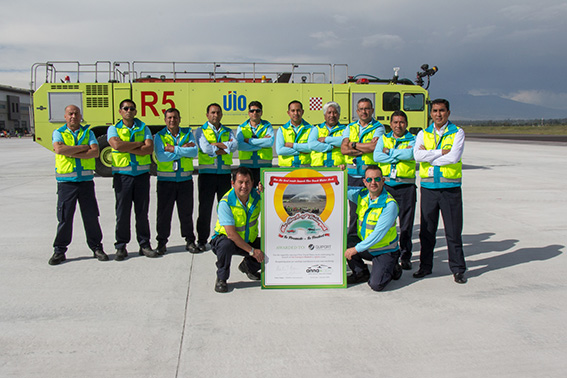
The Mariscal Sucre International Airport Firefighters won the first place in a competition organized by Airline Network News and Analysis (anna.aero) that honors the best water arch salute during an arriving or departing inaugural flight.
The arch that obtained this recognition took place on January 2, 2018, to honor Air Europa’s inaugural flight to Quito.
This tradition takes place at airports throughout the world in special occasions – such as upon commencing new operations – to wish good fortune to the airplane and airline.
In order to participate in the competition, the perfection of the water arch created by the airport firetrucks has been taken into consideration.
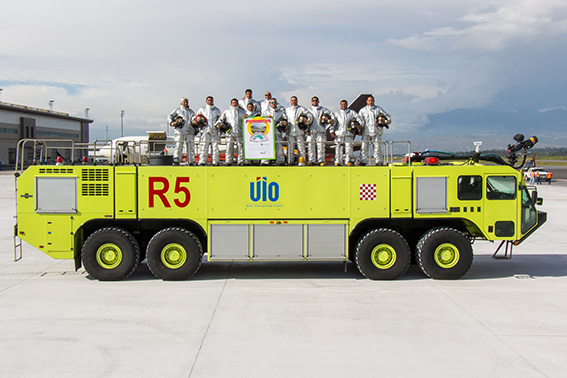
Such recognition demonstrates the perfect work and coordination of the Quito International Airport firemen who surprised the competition by taking care of each detail for it to so successfully be completed and, of course, without neglecting the protection of airport operations at the Ecuadorian capital city.
AIR EUROPA BEGINS ITS OPERATIONS IN QUITO WITH PROJECTIONS TO TRANSPORT 90,000 PASSENGERS PER YEAR
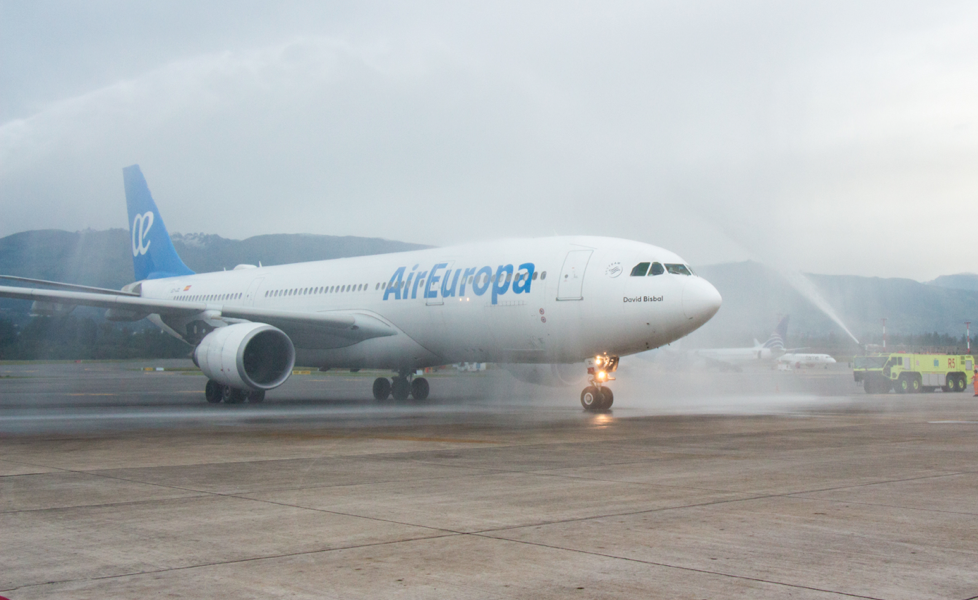
- The Spanish airline arrives to become a part of the map of routes connecting Quito and Ecuador with the world. The aircraft landed at 6:59 a.m. on January 2nd, coming from Madrid and departed for Europe at 9:20 a.m. after a heartwarming celebration.
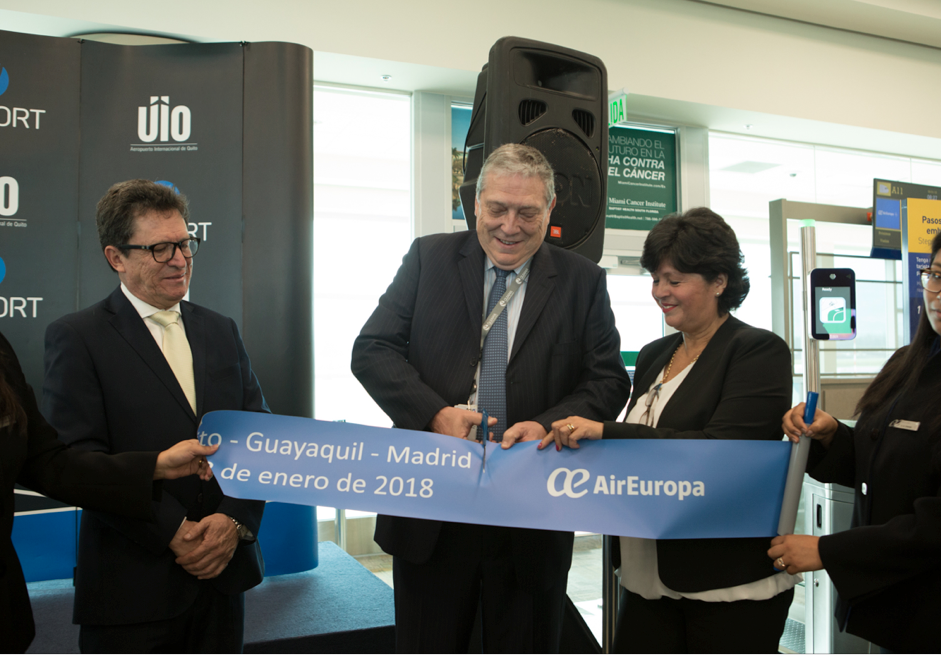
Gastronomic delicacies from the Iberian Peninsula, a welcome toast, and good wishes were the elements of the ceremony held by Quito’s International Mariscal Sucre Airport to celebrate the arrival of Air Europa at Ecuador’s capital and its integration into the air terminal’s strategy of greater connectivity performed through its concessionaire, Corporación Quiport.
At 6:59 a.m. on January 2nd, the A330-220 aircraft— with a passenger capacity of 299— landed on Quito’s soil after an 11 hour flight from Madrid’s Barajas International Airport. The customary water arch, routinely utilized to receive airplanes inaugurating a new route, signaled the beginning of Air Europa’s operations. For Ecuador, this route represents a possibility of expanding its commercial and tourism relationships.
Air Europa will cover the Madrid-Quito-Guayaquil-Madrid route, in a triangular flight that will have three weekly frequencies (Mondays, Wednesdays, and Thursdays) during the off-peak season and five frequencies during months considered to have high-demand (June, July, August, December, and January). According to the airline’s data, this route is projected to transport 90,000 passengers per year.
Andrew O’Brian, President and CEO of Corporación Quiport, explained that Air Europa’s arrival answers to a strategy that was planned based on demands for greater connectivity of the city and the country. The senior executive stated, “we are convinced that Ecuador’s development is strengthened by quality transportation services; the arrival of this airline will allow the expansion of the country’s tourism and business potential”.
Meanwhile, via Air Europa’s web page, the airline’s commercial director, Imanol Perez, highlighted, “for Air Europa, Quito was a long overdue destination. When we inaugurated a route to Guayaquil, one year ago, we had already stated our goal of transporting our passengers to Quito and demonstrating its great potential to them.” With Quito, Air Europa offers 21 destinations in the Americas, thereby progressively increasing the connection between both continents.
The designation of the Mariscal Sucre airport as the best airport in the region and dozens of national and international awards for its management are factors for airlines increasingly deciding to travel to Quito and reaffirming its status as a gate of entry to Ecuador.
Yves Gautier, director of operations of the Mariscal Sucre Airport, welcomed the passengers and crew of the inaugural flight highlighting that this is a great way to begin the new year in terms of growth for the Mariscal Sucre. “This responds to a general route development strategy. This year will bring lots of good news for the connectivity of Quito and Ecuador”, he stated in closing.
Germania Salme, Air Europa’s Commercial Manager in Ecuador stated that the airline’s arrival in Quito responds to the national government’s intentions to bolster Quito and Ecuador as a tourist destination.
The Ecuadorian Ambassador in Spain, Cristóbal Roldán, was present as a special guest of the event. Mr. Roldán emphasized the efforts of the national government to increase air connectivity. As an effort to achieve this, the President signed an “open skies” decree that aims to attract more international airlines to operate in Ecuador.
At 9:20 a.m., the aircraft started its engines to continue its return flight to Europe, making a prior stop in Guayaquil.
